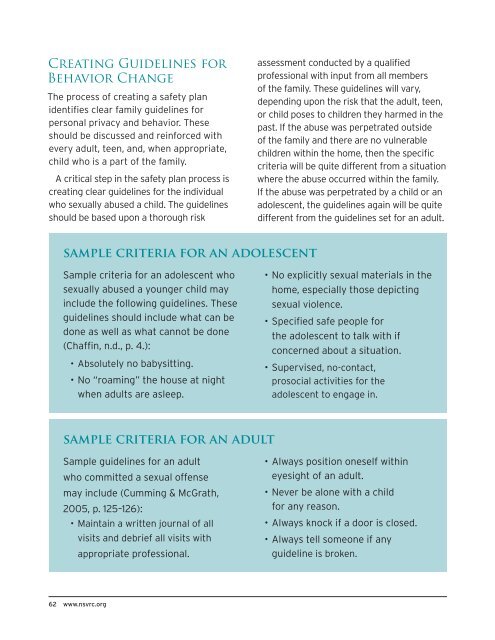Considering Family Reconnection and Reunification after Child Sexual Abuse
1VwGeds
1VwGeds
Create successful ePaper yourself
Turn your PDF publications into a flip-book with our unique Google optimized e-Paper software.
Creating Guidelines for<br />
Behavior Change<br />
The process of creating a safety plan<br />
identifies clear family guidelines for<br />
personal privacy <strong>and</strong> behavior. These<br />
should be discussed <strong>and</strong> reinforced with<br />
every adult, teen, <strong>and</strong>, when appropriate,<br />
child who is a part of the family.<br />
A critical step in the safety plan process is<br />
creating clear guidelines for the individual<br />
who sexually abused a child. The guidelines<br />
should be based upon a thorough risk<br />
assessment conducted by a qualified<br />
professional with input from all members<br />
of the family. These guidelines will vary,<br />
depending upon the risk that the adult, teen,<br />
or child poses to children they harmed in the<br />
past. If the abuse was perpetrated outside<br />
of the family <strong>and</strong> there are no vulnerable<br />
children within the home, then the specific<br />
criteria will be quite different from a situation<br />
where the abuse occurred within the family.<br />
If the abuse was perpetrated by a child or an<br />
adolescent, the guidelines again will be quite<br />
different from the guidelines set for an adult.<br />
Sample criteria for an adolescent<br />
Sample criteria for an adolescent who<br />
sexually abused a younger child may<br />
include the following guidelines. These<br />
guidelines should include what can be<br />
done as well as what cannot be done<br />
(Chaffin, n.d., p. 4.):<br />
• Absolutely no babysitting.<br />
• No “roaming” the house at night<br />
when adults are asleep.<br />
• No explicitly sexual materials in the<br />
home, especially those depicting<br />
sexual violence.<br />
• Specified safe people for<br />
the adolescent to talk with if<br />
concerned about a situation.<br />
• Supervised, no-contact,<br />
prosocial activities for the<br />
adolescent to engage in.<br />
Sample criteria for an adult<br />
Sample guidelines for an adult<br />
who committed a sexual offense<br />
may include (Cumming & McGrath,<br />
2005, p. 125–126):<br />
• Maintain a written journal of all<br />
visits <strong>and</strong> debrief all visits with<br />
appropriate professional.<br />
• Always position oneself within<br />
eyesight of an adult.<br />
• Never be alone with a child<br />
for any reason.<br />
• Always knock if a door is closed.<br />
• Always tell someone if any<br />
guideline is broken.<br />
62 www.nsvrc.org


